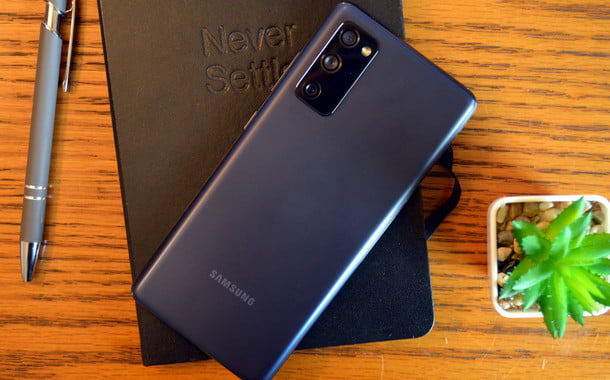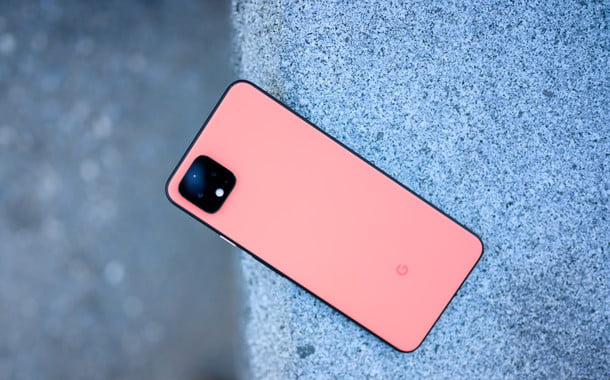Samsung Galaxy S20 FE Review: The Phone to Beat Under $700

"Most of the great Galaxy S20 experience for hundreds of dollars less – it's a winning combination."
-
Colorful design
-
Great display with 120Hz refresh rate
-
Great camera
-
5G connectivity (in the US)
-
Low price for the specs
-
Mediocre battery
-
Plastic back
There is no getting around it – phones are becoming very expensive. However, as flagship devices are becoming more and more expensive, a completely new market segment has emerged: the premium midrange. This is exactly where the Samsung Galaxy S20 Fan Edition lives. If you're looking for a premium Samsung experience without paying an arm and a leg, this is the way to go.
The name "Fan Edition" doesn't really describe what the phone really is. A better name would be the Galaxy S20 Lite. You don't really get all that the Galaxy S20 has to offer. But you get all the essentials with a few extra bonus features and a tempting price cut.
Hardware, design and display
It's clear that the Galaxy S20 FE is a derivative of the original Galaxy S20 – it looks just like the standard device. But it also consists of slightly different materials. Gone is the glass back in favor of the standard Galaxy Note 20's plastic back. Though it's not that high quality in theory, I like the soft-touch feel it offers and I didn't really miss the glass.
The device also differs from the standard Galaxy S20 in that it is available in a wider range of colors. I'm reviewing the Cloud Navy model, but it's also available in more interesting colors like Cloud Red, Cloud Lavender, and Cloud Orange. Safe to say there should be something for everyone.

The rest of the phone design is pretty normal. There is a USB-C port at the bottom, a volume rocker and a power switch on the right, and a rectangular camera module at the top left on the back of the phone. It's not as thick as the Galaxy S20 Ultra or the Note 20 Ultra, which is nice to see, but of course you don't get the same camera specs as the more expensive phone, either. We'll get into that later.
The Galaxy S20 FE is actually a bit larger than the standard Galaxy S20. While the original device has a 6.2-inch display, the S20 FE has a larger 6.5-inch display. Also in contrast to the Galaxy S20, this phone has a resolution of 1080p. It seems that the high resolution is a feature that Samsung wants to reserve for its more expensive devices.

It still looks good. It's a Super AMOLED display with an impressive 120Hz refresh rate, just like the other S20's. The result is an extremely smooth experience and a display that responds very well to touch. We hope to see more high refresh rate phones showing up in the next year, but by then it's pretty impressive to see a $ 700 phone running at 120Hz. It also beats competitors, if only marginally.
The most obvious competitor here is the OnePlus 8, which also has a resolution of 1080p but limits the refresh rate to 90 Hz. (The upcoming Google Pixel 5 will also have a 1080p 90Hz display.) To be clear, the difference between 60Hz and 90Hz is much more obvious than the difference between 90Hz and 120Hz. But for those who can notice a difference, 120Hz is estimated.
It should also be noted that the display is flat and not curved. I like the look of curved displays, but others disagree. With the flat panel display in mind, there is no way you should run into so many problems related to accidentally squeezing your palm.
Performance and specifications
Samsung has made clear compromises in design and display, but not really under the hood. You still get a Qualcomm Snapdragon 865 processor in the US 5G version, or an Exynos 990 outside of the US, coupled with 6GB or 8GB of RAM – and as a result, the phone can easily handle anything you can throw at it in 2020 and beyond. This includes productivity apps, mobile games, etc.
Predictably, the phone handled games like Call of Duty: Mobile with no problem, and multitasking with even four or five apps is no problem. The benchmark results confirm the excellent performance in daily use. Here is an overview of the results we have achieved.
- AnTuTu: 550,800
- GeekBench 5: 889 single-core, 3,101 multi-core
These results don't quite get as high as we got with the OnePlus 8, but they are close and in real life you won't really miss the extra 20 single-core points on GeekBench 5, check the 6GB RAM model in the lower price range. So, if you really care about this performance benefit, upgrading your RAM might be the way to go.
Cameras

Gone are the days when incredible cameras were reserved for the best of the best phones. With devices like the Google Pixel 4a, it is becoming increasingly clear to phone makers that those who spend $ 450 or more on a phone should be able to get a premium camera experience. While you don't get the same zoom quality as the Galaxy Note 20 or the same main resolution sensor as the Galaxy S20 Ultra, the Galaxy S20 FE still offers a versatile, high-quality camera experience.
The phone offers three camera sensors, including a 12-megapixel standard sensor, an 8-megapixel sensor with a telephoto lens, and a 12-megapixel sensor with an ultra-wide-angle lens. I really appreciate that, and while some might prefer either a telephoto or an ultra-wide device to the other, simply having both means the camera will be useful in all sorts of situations.
On paper, the specs don't quite match the standard Galaxy S20, but the photos seemed pretty good in everyday use. They're still colorful and crisp, with enough dynamism to create a punchy photo, but not so much that they wander into unnatural territory. These days, photo quality may have more to do with post-processing than sensor quality. So it makes sense that the slightly worse specs don't really result in worse photos than the Galaxy S20.
The photos are pretty good in low light. As you would expect, photos can get noisy in very low light. However, in general, the phone can capture enough detail to get decent shots. The same goes for really enlarged photos. The telephoto camera offers 3x optical zoom and up to 10x digital zoom – and the result is up to 30x hybrid zoom. Photos at this zoom level aren't that sharp, of course, but Samsung has invested seriously in cleaning up zoomed footage from its photos, and it shows. The 3-10x shots are solid, but you'll rarely want to use 30x.
Dimmed light
30x hybrid zoom
3x optical zoom
The selfie cam looks pretty solid too. The front-facing camera is 32 MP and doesn't have the dual-phase detection autofocus of the original Galaxy S20, but it still captured colorful selfies with more than enough detail. The higher resolution selfie camera is here for a reason – if you're not using the wide angle sensor, the picture is really just being cropped, and therefore the photo is only at a lower resolution.
One feature that the Galaxy S20 FE lacks is the ability to record videos in 8K. This is because you will need a higher resolution camera to do this. Even so, the camera can record 4K video at 60 frames per second, which should be more than enough for most, and saves you the maximum storage capacity.
Battery life and charging
Power is supplied by a 4,500 mAh battery, which apparently can be used for a whole day without any problems. I ended a heavy use day with about 20% battery remaining, which is not a ton but is still okay. If you are used to charging your phone every night, you shouldn't have any problems.

Fortunately, the phone is easy to charge too. Unlike the OnePlus 8, this phone supports wireless charging. You also get 25W wired fast charging. At this point I was distributing wireless chargers around my house so it was nice to be able to use them while testing this phone.
software
As expected, the Galaxy S20 FE comes with the Samsung One UI 2.5 (Android 10). I'm not going to go into the specifics of the Android customizations – you can read extensive settings in our Galaxy S20 and Galaxy Note 20 reviews – but I'll say that the bloatware on this phone seems to have been reduced a bit compared to some others . This is mainly due to the fact that you can instantly choose which apps are installed on your device. While all of the additional Samsung apps and Microsoft apps are enabled by default, just take the extra moments to adjust the pre-installs when you set up your phone, it's worth it.

In general, the software was responsive and smooth. Love or hate One user interface, Samsung has done a great job of making the entire user interface coherent and easy to use with one hand. Samsung wins for customizability too. So if you really enjoy optimizing and thematizing, you will enjoy the experience here.
Our opinion
The Samsung Galaxy S20 FE offers the flagship cell phone in a $ 700 cell phone. You really don't miss much here. Sure, a screen resolution of 1440p is always good, and some of the camera specs don't reach the height of the standard Galaxy S20 or Note 20. But with a premium processor, still awesome display, premium feel, and great camera system, you are it can't do much better in the price range.
I would have liked Samsung to have brought out this phone along with the rest of the Galaxy S20 lineup, but it makes sense why it didn't in order to get those high sales first. However, if Samsung continues to bring out phones of this quality in this price range, companies like OnePlus should be very concerned.
Is there a better alternative?
It depends on what you are looking for. The OnePlus 8 is the main competitor here. While it's a great phone, it doesn't have the same camera quality, it doesn't hit the 120Hz refresh rate, and it doesn't charge wirelessly. However, OnePlus offers a cleaner and arguably better software experience.
If you are really on a budget then you should also consider the Pixel 4a or wait for the Pixel 4a 5G. They have amazing cameras and simpler software, although the specs and performance don't match the Galaxy S20 FE or the displays.
Of course, if you're not married to Android, then you should also consider the iPhone 11, which is available at a similar price, has even better performance, and a fantastic camera. However, you will not get the same ad. You also don't get 5G and have to deal with the iPhone notch.
How long it will take?
With Snapdragon 865 water resistance and IP68, the Galaxy S20 FE should easily survive a normal two year phone cycle and longer if you want or need it. Again, the plastic back helps here – while it doesn't feel premium, it helps keep the phone more likely to remain crack-free throughout its lifespan.
Should you buy it?
Yes. Sure, you could spend an additional $ 300 on a slightly better phone, but if you want flagship quality for $ 700 this is the phone to beat right now.
Editor's recommendations














































